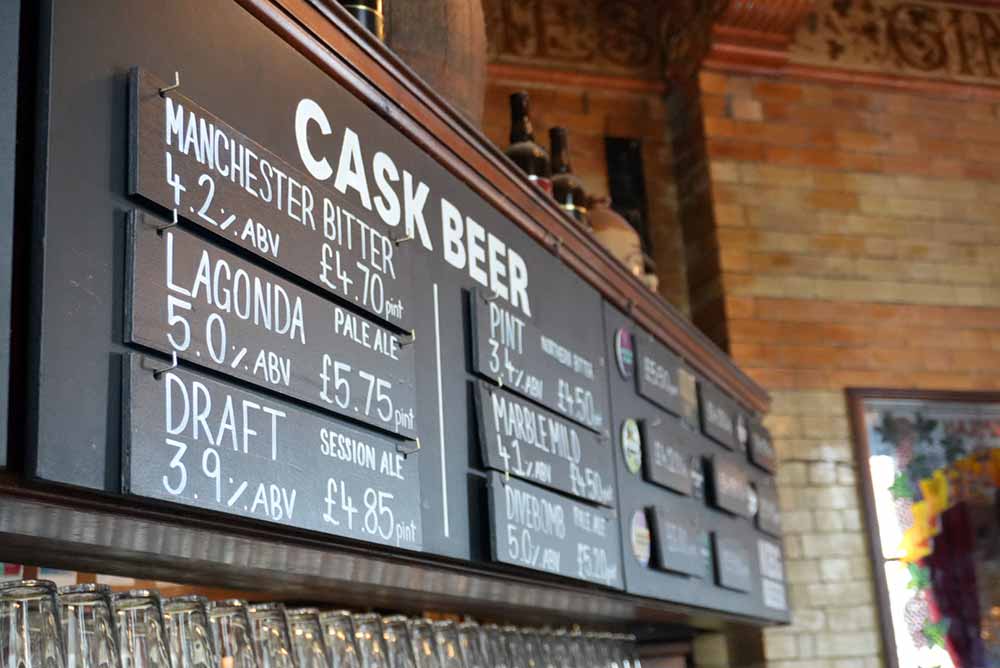Shop
The London Black Nitro Beer Giving Guinness a Run for Its Money
David vs. Goliath.
Looking for More Stories Like This?
The two glasses stood tall on our table, brown liquid cascading and bubbling to black. I palmed the imperial pint, bringing it to my lips. A rush of robust, roasty beer hit my mouth, the texture of satin pajamas against my tongue—like a Guinness on steroids. One could argue that if there is one beer you must drink during your time in England’s capital, it’s the London Black from Anspach & Hobday.
The nitro porter has gained a reputation as one of the best, if not the best, beers in London.
And it’s giving Guinness a run for its money.
All from one little London brewery named after a couple of lads who met in kindergarten.
From Kindergarten Kids to British Brewers
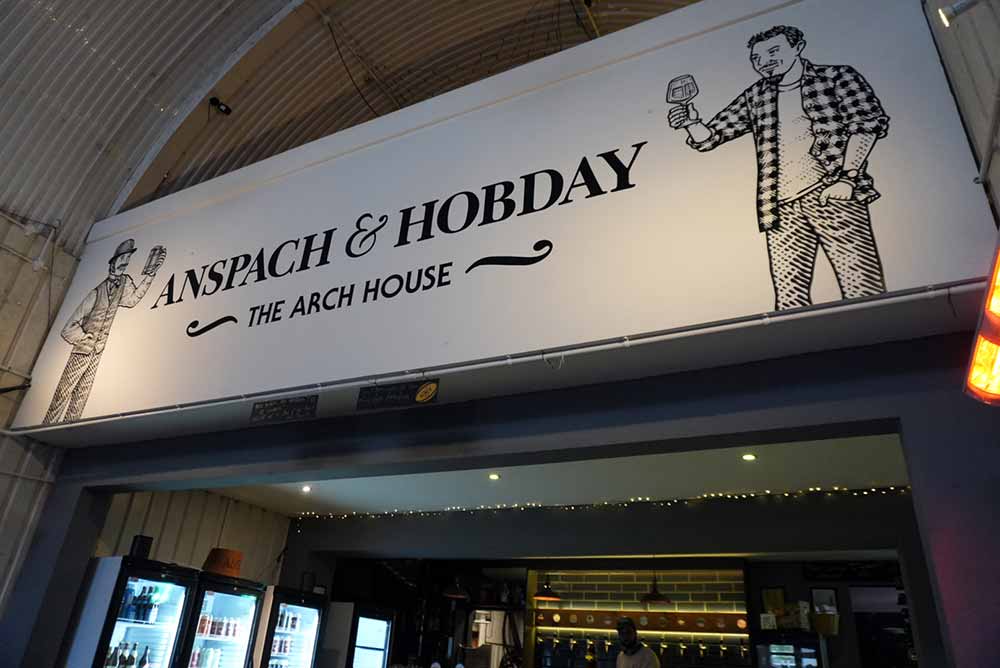
Photography courtesy of Grace Lee-Weitz | Hop Culture
Friends since kindergarten, Anspach & Hobday Co-Founders Paul Anspach and Jack Hobday started homebrewing at university. “We did two IPAs, which were rubbish, and then we brewed a porter,” said Anspach. “London water is just not suited for making pale beers without any treatment, so we thought, let’s just try something new…and it clicked.”
At the time, Anspach & Hobday were homebrewing out of a flat they shared in South London with a third roommate, who wasn’t thrilled with them setting up the brew kettle in the bathtub.
“You’d have hops in the plug hole, and it kind of smelled,” said Anspach, who started working at a wine shop to make ends meet. After he took over curating beer for the shop, Anspach said he’d give out samples of their porter to anyone who wanted to try it.
“People started asking, is this a business [because] we’re looking to invest in breweries?” Anspach recalled.
Fresh out of university, the duo wrote a business plan. Originally considering contract brewing, they found a brewery in Kent. But the owner emailed them a few weeks before their first brew day to say he decided to close.
At the time, breweries were opening up left and right in these unused railway arches owned by the Network Rail train company. The area had become so popular for start-up businesses that the train company even started its own online database, tracking when arch spaces became available.
“This one came up, and it seemed like a bit of a no-brainer,” said Anspach, gesturing around the space as we shared a pint. Anspach had invited me out to their taproom in what has become known as the Bermondsey Beer Mile to see exactly what this London Black is all about.
We sat underneath a mural depicting Victorian-style cartoon versions of Anspach and his business partner and longtime friend, Jack Hobday.
Anspach explained that when they first moved into the “Arch House,” as they call it, they originally planned to share the space with another new brewery called Bullfinch. But the founder, a full-time touring sound engineer, spent more time on the road than in the brewery. So they pretty much had the space to themselves.
After raising £5,000 on a Kickstarter to buy their first legit brew kit, Anspach & Hobday opened to the public in 2013 with just two beers on the menu: a Smoked Brown and an original porter simply named The Porter.
First, a Smoked Brown; Second, a Not-Yet-Nitro Porter
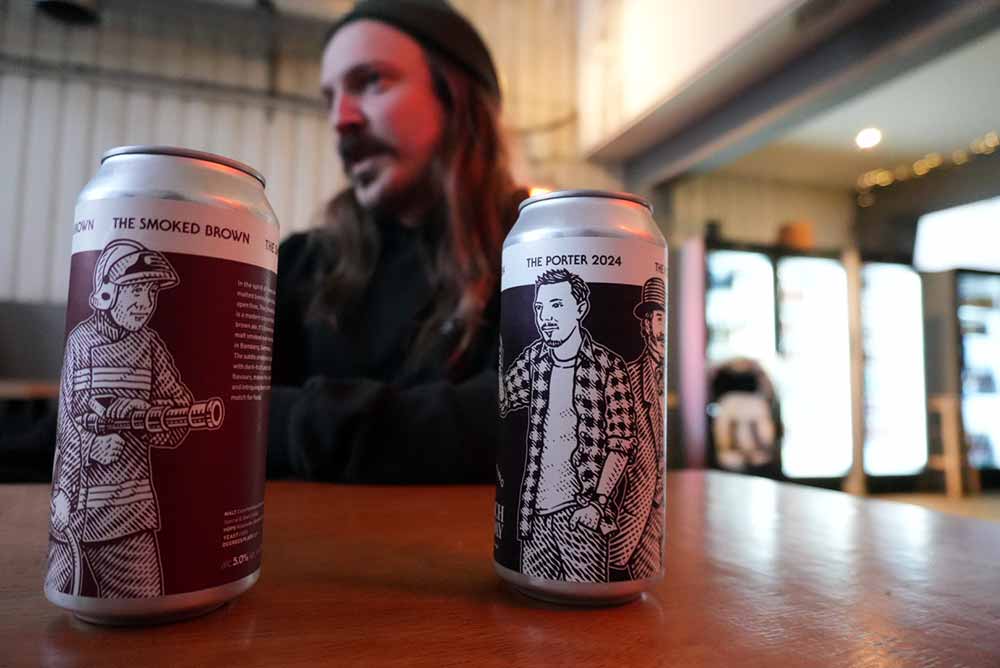
Photography courtesy of Grace Lee-Weitz | Hop Culture
“Obviously, that was a bit of an unusual starting lineup for a brewery,” said Anspach, as he cracked a can of the former and poured out a couple of tasters for my friend and me.
The Smoked Brown, in particular, felt like an odd choice.
But as Anspach shared, “I absolutely love smoked beers,” naming Scherlenka as one of his top three beers of all time.
Anspach got the idea for a smoky brown beer from a forum on old English brown malt, talking about how historically, darker kilned malts had a smokiness to them. Someone on the page mentioned you could approximate that flavor by blending German smoked malt and Belgian crystal malt together. “You get this rich, brown, smoky malt,” Anspach recalled. “It’s not a full-on rauchbier. Just [a beer] with a little smoky element.”
For Anspach & Hobday’s version, they used Brambling Cross and Willamette hops with “some berry-like fruits, and then we actually age it on oak chips for two or three days to get a very subtle wood character,” Anspach told me.
My friend chimed in as she sipped, “Tastes like fire!”
I agreed the beer had a pleasant smokiness, but it wasn’t like blowing up in your face. More like waking up the next morning after sitting around a campfire and still smelling a faint hint of smoke in your hair or on your clothes.
Overall, in the beginning, Anspach admits they were a bit all over the place, “scrabbling around trying to find meaning.” Inspired by European brewing traditions, the brewery pushed out everything from saisons to smoked beers and “really tried to get a cream ale going,” but in the middle of it all, even if the smoked brown would come and go, they kept that original porter.
After all, the style had an important place in British brewing history. Brewed as a darker, richer version of the English mild brown ale, porter earned its name from the people who drank it most: dock workers (aka “porters”).
“It’s a style which is really, really, really important to London,” Anspach said. “It’s fundamental that a London brewery should be brewing a porter.”
As we drained our pints of Smoked Brown, he told me the recipe for the original porter hadn’t actually changed much from the pair’s early homebrewing days.
Anspach starts with straight-up London water, which is perfectly suited for making porter. For the base, they use English pale malt with a blend of amber, chocolate, and black malt before adding East Kent Goldings and Cascade hops and a very clean American yeast ale strain that “lets everything else come through,” said Anspach. “It’s just super reliable; pretty simple.”
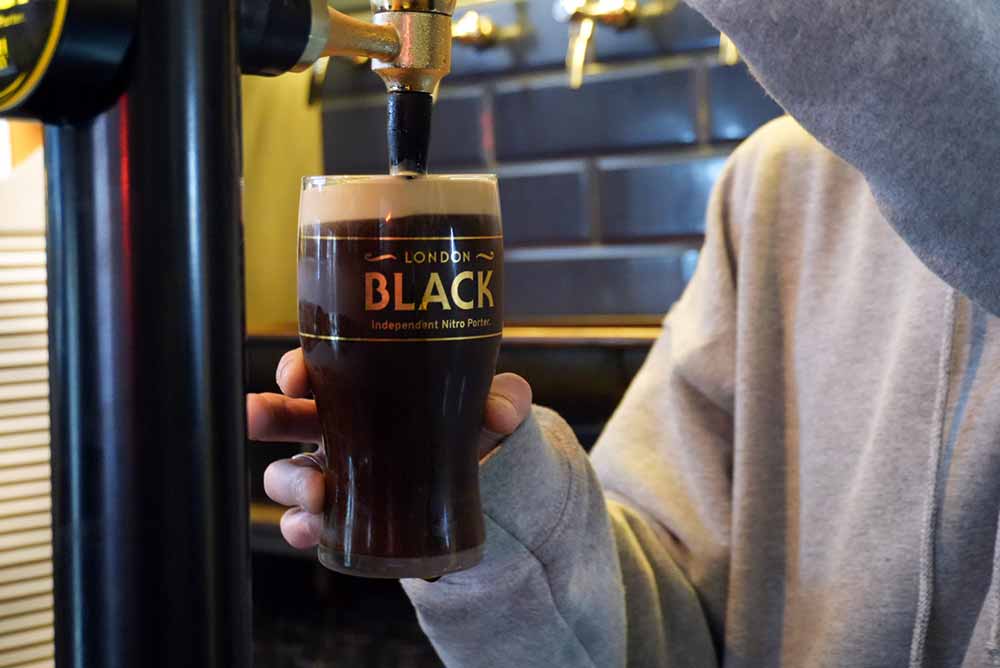
Photography courtesy of Grace Lee-Weitz | Hop Culture
Anspach & Hobday Bartender Courtney Wilson fell in love with this beer as a consumer ten years ago while on a brewery walk around the Bermondsey Beer Mile. “There’s a reason the OG is the number one porter,” he told me as he expertly poured a nitro London Black for a couple standing at the bar, where you’ll now find the nitro tap front and center. “It’s like engine oil in a glass; it’s a proper London porter.”
Something Wilson attributes to London’s water profile, which helps make this porter “super rough around the edges.”
And Wilson isn’t the only one to consider this beer “the perfect porter.”
“I think it’s still in, like, Ratebeers’ top thirty porters in the world,” said Anspach. “That beer started the whole thing.”
But despite the beer’s success, Anspach & Hobday felt the brewery was still missing something.
Well, actually, they felt like London lacked something: an iconic version.
Dublin had Guinness. France had wine and champagne. But London? “If you went to Bordeaux, there’s no way that you’ll be able to drink anything other than Bordeaux. … If you’re in Champagne, and you ask for a glass of Prosecco, they just show you the door, right?” laughed Anspach. “But with beer, we don’t have that. … It’s insane that the most drunk beer in London is an Irish import.”
He’s talking about that good ol’ Irish dry stout. “I think the stat was like one in ten pints sold in London is Guinness,” said Anspach. “Now, that’s crazy.”
What if, just what if, Anspach & Hobday could make a nitro beer to compete with the best of the best?
Now, that’s crazy, too, right?
David vs. Goliath, London Black vs. Guinness
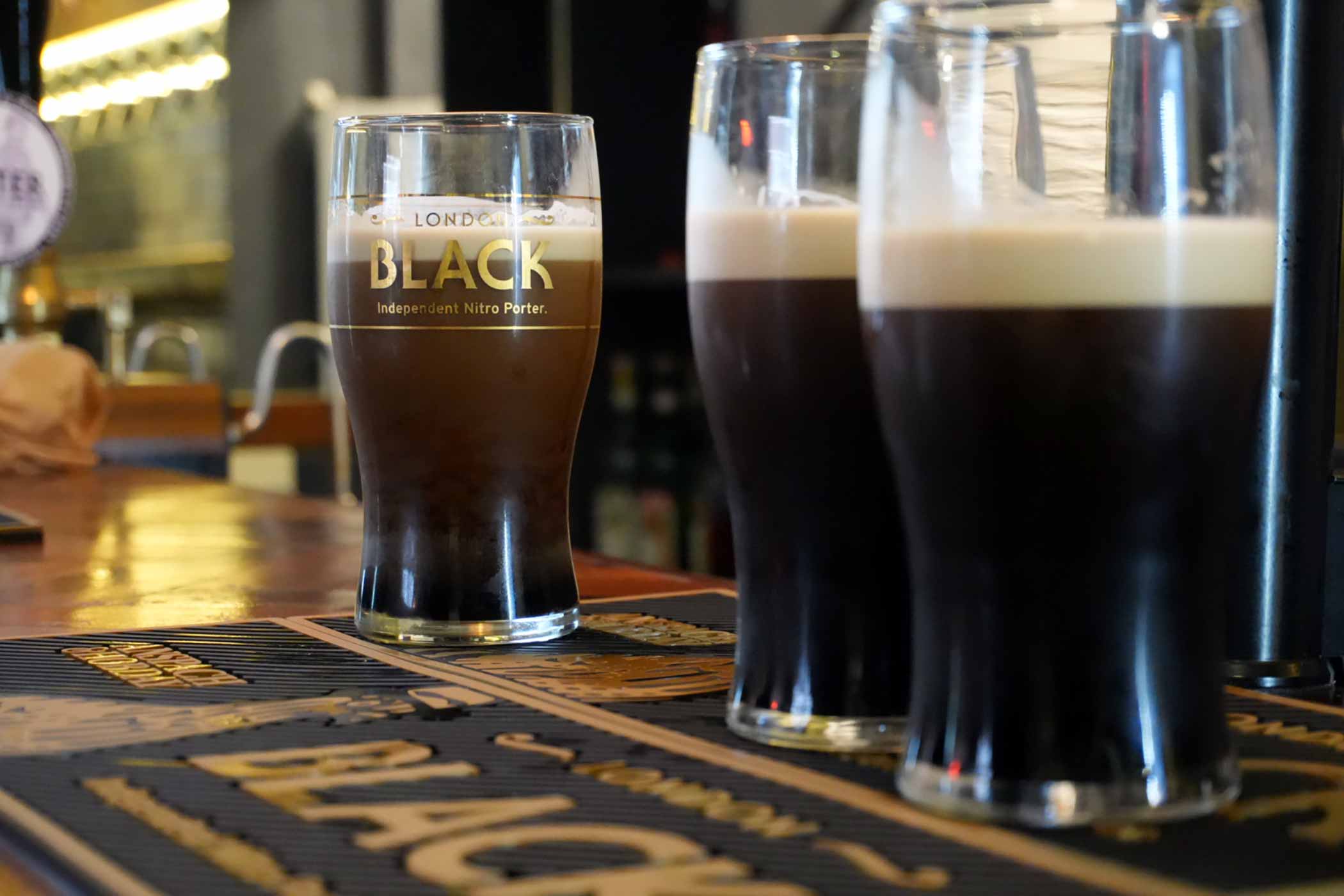
Photography courtesy of Grace Lee-Weitz | Hop Culture
When the pandemic forced Anspach & Hobday to close the then-seven-year-old taproom, they took the time off to reevaluate the business, asking a critical question: “How do we represent [porters], which are fundamental to who we are as a brewery, but in a way that’s actually commercially viable?”
They saw the success of Guinness, a sessionable 4.2% ABV nitro stout, and just thought, why not give nitro a go?
Despite never having brewed a nitro beer.
Despite not even owning a nitro tap!
I mean, the gumption, right!?
Their first time brewing London Black, “we thought it looked just about okay coming out of the tank, so I drove here with a keg of it, converted one of the lines over to nitro, put it on, poured it, and you just saw the magic happen,” Anspach remembered. “No one else was here, but I was like, oh my God, this is amazing; we’ve done it; it’s great!”
The recipe closely followed the original porter with a couple of small tweaks for nitro. Mainly, they replaced the black malt with a blend of highly roasted and kilned malts to give the beer color. And, whereas The Porter reaches 6.7% ABV, London Black only gets to 4.4% ABV.
“With the original porter at that strength, it was never really a volume beer,” said Anspach. “It got us a reputation … [but we wanted] something sessionable.”
When the world opened up again, Anspach & Hobday had a beer “strikingly different to anything we’d done before,” said Anspach.
More than that, they had a solution for many pubs. He said, “They needed a Guinness equivalent. They needed a solid, reliable 4.5% ABV porter or stout. We ticked that box.”
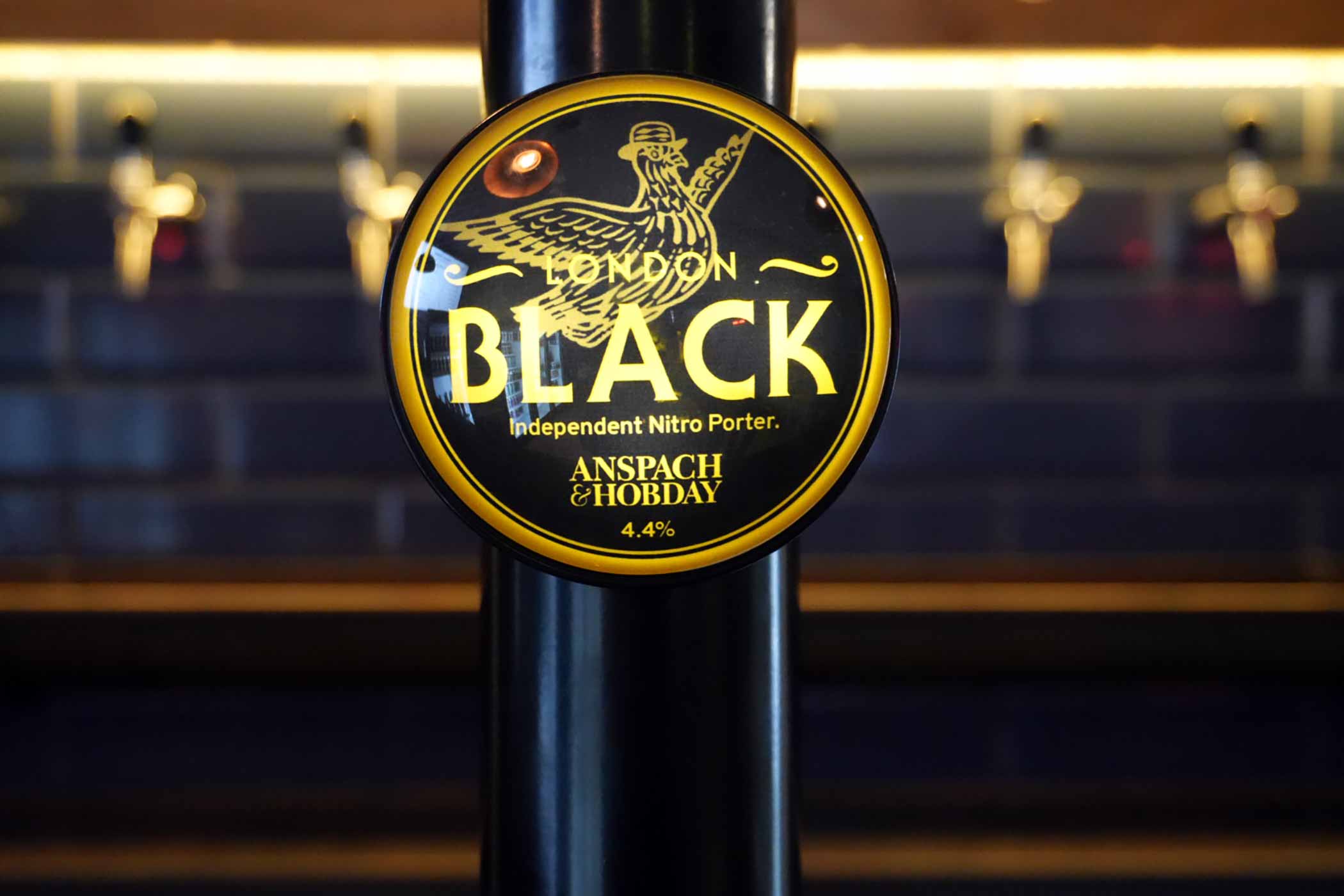
Photography courtesy of Grace Lee-Weitz | Hop Culture
Plus, Anspach smartly agreed to do the cellar work for any pub that needed to install a nitro line and tap, removing any barrier to entry. “We really hit the ground running, and it just kicked off,” said Anspach, sharing that he did three to four installs per week in the beginning.
Today, London Black accounts for over seventy percent of Anspach & Hobday’s output. Walk into the taproom on a Friday, and Anspach says eighty percent of the people inside will have London Blacks in front of them.
Incredibly, Anspach & Hobday now directly competes with Guinness.
“You’ve got this David and Goliath fight thing, which is very attractive for people,” said Anspach, who quickly points out that these are different beers.
“We don’t really go after Guinness,” Anspach said with a shrug. “This is an alternative. It’s different. It’s porter. It’s more flavorful. It’s more complex.”
The beer certainly packs a punch, holding its own in the nitro ring. Anspach & Hobday certainly aren’t the first craft brewery to brew a nitro porter or stout, but they’ve approached it in a very meaningful way. “We let it be the core of our business,” explained Anspach. “We showed if you can bring down those barriers for people then you can get in there, and there is space.”
Helps that the beer tastes absolutely f**king delicious. To me, the smoothness and drinkability stood out most from the first sip, backed up by a robust flavor profile.
“A lot of the flavor notes you talk about sound pretty bold,” Anspach shared. “There’s definitely notes of roasted coffee and chocolate…but it’s more like a dark chocolate and then dark fruits like red currants.”
The more Anspach and I emptied our glasses, the more he kept going back to the beer’s balance. “Ultimately, the main thing is it’s very, very balanced, very, very smooth, and very easy to drink.”
To show you how much I agree, I actually ordered a Guinness later in the night at my hotel bar, curious to taste a comparison.
Probably the worst Guinness I’ve ever had.
London Black just made such an indelible impression on my mind that my taste buds found it hard to go back.
High praise for a beer style with humble beginnings. And despite all the attention, Anspach would prefer to keep it that way.
“If we can tell the story about porter and about why it’s from where it is, then great,” he said. “If equally, if no one cares about that and they just want to drink it and it’s nice, have at it, you know. It’s all good, I think!”
London Black to the Future
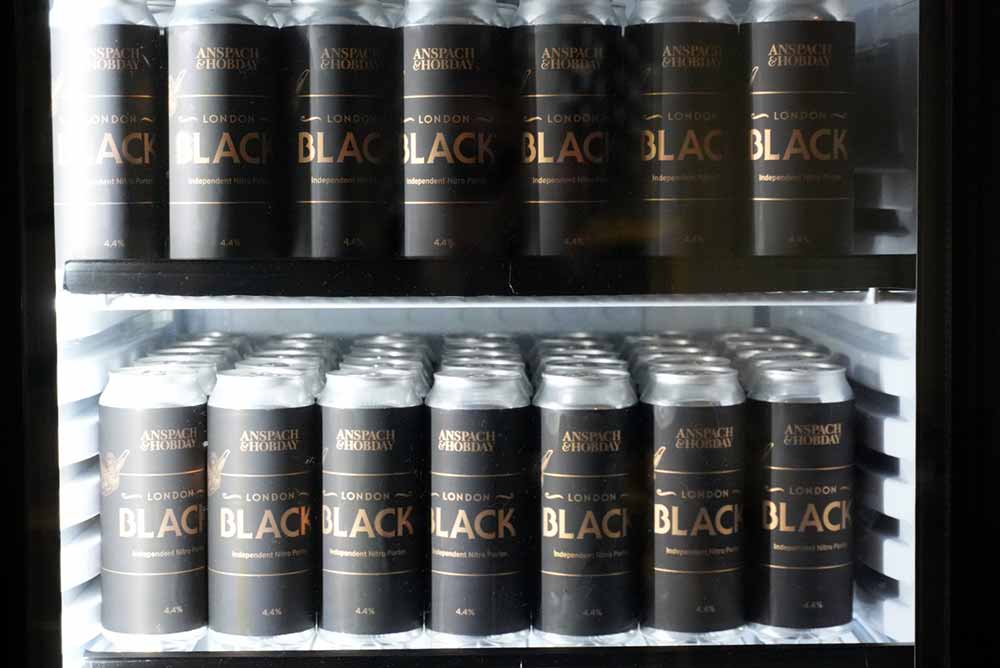
Photography courtesy of Grace Lee-Weitz | Hop Culture
I’m not the only one who leaves Anspach & Hobday with London Black on their mind.
These days you’ll find Wilson slinging expertly poured London Blacks one after another, a skill he learned from a local where he used to work that favored Guinness. “I tell people, this is going to be the best-looking pint you’ve ever had in your life,” he said with a bit of a smirk.
He’s not lying.
During the few hours I spent at Anspach & Hobday, I’m not sure I saw someone order anything else.
The buzz this beer has generated cannot be understated, and it’s about to get a whole lot buzzier.
Next to Wilson, a whole case full of London Black cans stood bright and gleaming, ready for people to pluck and take home.
This is a new packaging format for the nitro porter.
Anspach said they decided to go with a widget, but it took them a while to dial things in because their canning line wasn’t quite set up for a streamlined process. He explained that every single can needed to be manually inverted as soon as it was seamed so the nitrogen gas would be forced into the widget glued to the bottom of the can. “It’s a matter of seconds before that nitrogen entirely evaporates, so you needed someone standing there,” said Anspach, who volunteered himself to hand-turn every can. “Let’s just say I now have sympathy with the working class children of the Victorian era.”
Anspach says, until they get upgrades to their canning line, they’ll be filling about 300 to 400 cases a month.
And once they’re completely happy with London Black in cans, they plan to give the nitro treatment to another beer, the Original Bitter Smooth.
At this point, Hobday popped quickly into the conversation. ”You’ve talked to Paul so much that he’s lost his voice!”
A clear sign to us that we’d probably enjoyed one London Black, The Porter, and Smoked Brown too many.
As we layered up and walked back out into the blustery London night (dare we say the London Black night), every table we passed on the way out had glasses standing tall on their tables, brown liquid cascading and bubbling to black.
Dublin has Guinness. Could London now have the London Black?
As Anspach put it, “It’s been a pretty wild ride, to be honest.”




